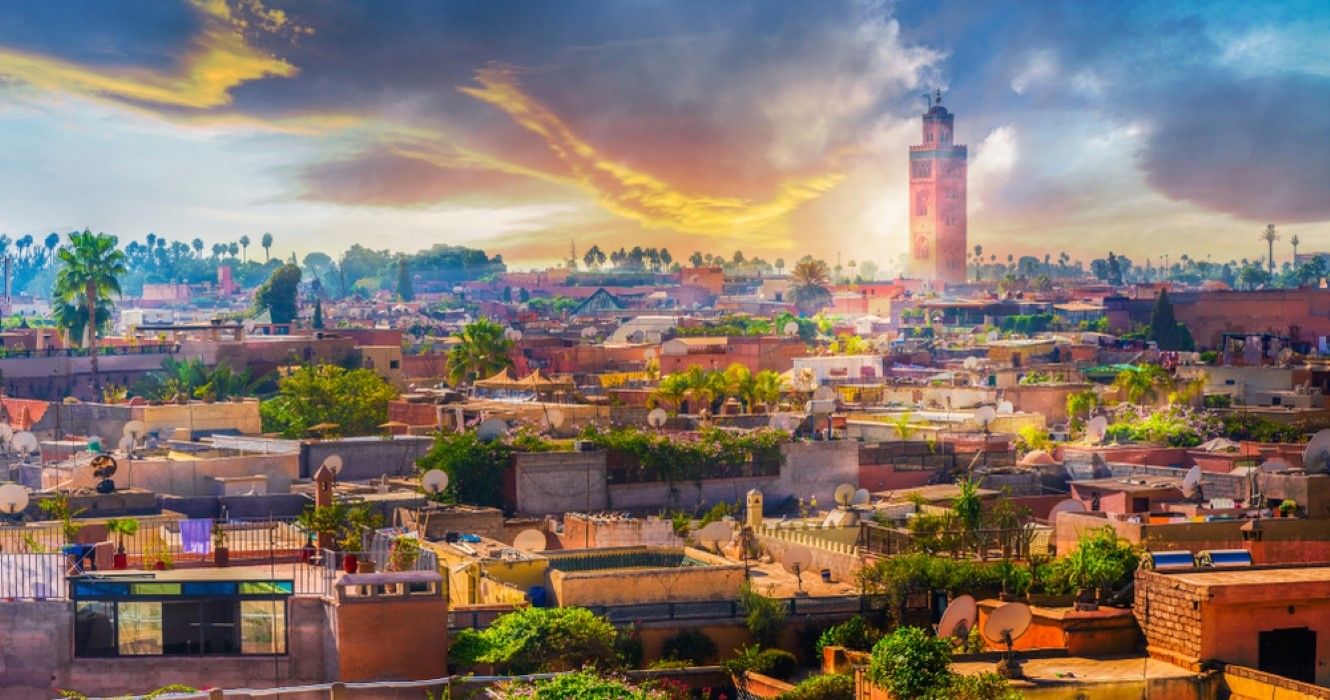Quick Links
A trip to Marrakesh, Morocco, the "Jewel of the South," is sure to be an unforgettable experience. Images of jewel-colored alleys and the vivid scents of spices boiling come flooding back, even years later. An excellent place to experience Marrakesh is the Medina, the city's ancient town and bustling heart.
The Medina is a labyrinth of winding alleys and colorful souks that have changed little in the hundreds of years since it was built. Learn where to eat and shop, and discover why this attraction of Marrakesh is so famous.
The Past And Present Of The Medina Illustrate Its Outstanding Universal Value
Marrakesh, established in 1070-1072 by the Almoravids, reigned in North Africa and Andalusia for a long time as a significant political, economic, and cultural hub of the western Muslim world. Massive structures from that period include the Kasbah, ramparts, magnificent gateways, and gardens, and the Koutoubia Mosque, whose incomparable minaret reaches a height of 77 meters and is a symbol of the city.
Over time, the city welcomed the Badiâ Palace, Ben Youssef Merdersa, Les Saâdians Tombs, Bahia Palace, and several other grand residences. Similarly, the open-air theater at Jamaâ El Fna Square has been included on the Representative List of Intangible Cultural Heritage.
The Medina of Marrakesh, now a UNESCO World Heritage Site, retains all the original cultural and environmental components that gave rise to its outstanding universal value. The natural environment (especially the Gardens of Aguedal, Ménara, and Palm Grove) and the construction materials and decorations in constant use are still protected, original, and well-preserved.
The Medina Is An Excellent Place For A Shopping Spree
Traditional merchants' markets, known as souks, draw many visitors to the Medina. Loaded with the exotic aromas of spices and leather, they are noisy with the chants of competing merchants and are noisy with the chants of competing merchants.
When visiting, head to Souk Semmarine, the city's main street, to pick up some souvenirs at the tourist bazaars lining the streets here. Shoppers can discover better prices and a more genuine atmosphere at the themed souks that branch off from Souk el Attarine. Here, enjoy the colorful towers of spices, exotic perfumes, and shiny metallic goods like silver teapots and beautiful copper-and-stained-glass lanterns.
And then there's the Souk des Teinturiers, where brightly colored bolts of wool and fabric adorn the kiosks, and the Souk Smata, where shoppers can buy embroidered Moroccan slippers.
The Medina's Culinary Culture Is One To savor
Morocco now has some of the best food in North Africa due to centuries of imperial and commercial interaction. Morocco's cuisine is a cultural melting pot, with influences from Arabs, Berbers, Moors, French, Middle Eastern, Mediterranean Africans, Iberians, and even Jews due to the country's strategic location. The Djemma el Fna is a great place to try some local cuisine in Medina.
When the sun goes down, the people of Marrakesh come out to celebrate in Djemaa El Fna, the city's central plaza in Medina. Expect to see women painting henna tattoos, snake charmers, and friendly and intelligent trained monkeys.
People from all around the world share meals at long tables as aromatic smoke rises from open fireplaces. Pick a bustling vendor and tuck it into grilled meats, delicious Moroccan tagines, and snail soup (a local delicacy). Djemma el Fna also features many permanent eateries.
What To Keep In Mind While In Marrakesh
Visitors should feel secure wandering the Medina but remember that pickpockets love crowds, so it's best to keep valuables hidden. Avoid drawing attention and leave flashy jewelry and expensive cameras.
It's essential to watch out for con artists, especially in Djemma el Fna. Attempts to exchange fake currency and "gifts" that the recipient will be asked to pay for are two of the most typical types of fraud. In Medina, haggling with vendors is expected and often leads to heated exchanges.
The rule of thumb is to only inquire about the price of an item if one is seriously considering making a purchase and then offer half of that amount as a starting point for negotiations.
When To Go To Marrakesh For The Best Weather And Experiences
March through May and September through November are prime periods to explore Marrakesh. Hotel prices are typically lower, and the weather is more pleasant during these shoulder seasons (with average daytime temperatures in the mid-70s to low 90s).
Avoid the crowded summer months when the temperature in the city consistently exceeds 100 degrees. In the winter, when temperatures in the Red City typically vary from the mid-40s to the high 60s, the city sees a large influx of tourists from regions with cooler climates.

